Do you know what your cat does when she eats? You’re probably giving me a little bit of a blank stare right now, like, she puts her face in the bowl and chews her food (or maybe like some cats, she doesn’t chew it much at all…).
You throw your cat’s food down and walk away so many times, but you might be missing some of the interesting behaviors that your cat is engaging in while she eats. Furthermore, a new study in the Veterinary Journal suggests that the behaviors that your cat engages in while she’s eating might tell you just how much she likes the food.
Before we get into this new study, let’s review some of the things we already know about how cats eat. Cats are obligate carnivores, and their teeth are really designed for shearing meat into strips, which they then swallow mostly whole. Not a lot of chewing going on… have you ever seen a cat throw up after they eat some dry food? It looks pretty much the same as it looked going down…
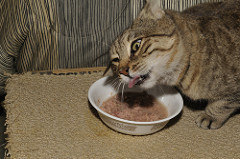
As obligate hunters, cats also engage in a few interesting behaviors while they are eating, such as placing some of their food on the ground or tilting their head to the side while they chew. This behavior is because if they were eating a bird or rat, the body would likely be dragging on the ground. The harder the food is to chew, the more you’ll see a cat’s head tilt. Cats also shake their heads when they pick up a food item or a small bite of food. Leyhausen attributed this behavior to the instinct to shake a bird that has been killed to loosen the feathers. Cool! Even your kibble fed kitty has instincts related to the cat’s evolution as a predator.
The new study, A Novel Set of Behavioural Indicators for Measuring Perception of Food by Cats, took place in Finland. The goal was to categorize what types of behaviors cats presented when eating their favorite food, as well as a less favored type of food, and finally to test out whether or not cats would notice if there was a tiny pill hidden inside their favorite food.
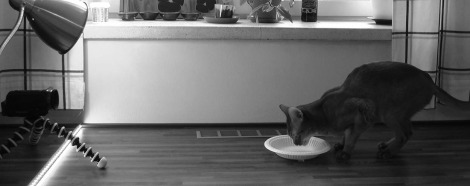
Researchers had 34 house cats from 17 households participating in the study. I love that they were able to conduct this study in the cats’ homes with owner assistance! Owners were asked to film the cats eating in a standardized way such that the camera was 70 centimeters from the food bowl on an elevated surface. Each cat was fed 1 of 3 food types: their favorite food (often sausage or a meatball, but for one cat a boiled egg), a less desirable food item such as a vegetable or rye bread (!?), or their favorite food with the placebo pill hidden inside.
The researchers developed a lovely ethogram of the different behaviors that cats showed while they were eating. These included flicking their ears backwards, licking their nose, flicking their tail, dropping the food, shaking their head, licking the bowl, sniffing, licking their lips, and grooming their body. Results suggested that when a cat was eating a less desirable food, they were more likely to flick their tail, groom their body, flick their ears backwards and lick their nose without tasting the food. Cats who ate their favorite food were more likely to lick their lips. But when the pill was hidden in their favorite food, the cats were more likely to drop the food or the tablet while eating it.
One of the goals in hiding the tablet in the delicious food, was to see if this could be an effective way to medicate cats. Many cat owners report difficulties pilling their cats, so coming up with something that would be palatable and able to be disguised in regular food would be of great benefit to cats and humans alike. The bad news is that the cats were not fooled. It seemed that they were happy to start eating the food, but once they detected it, they stopped eating. Back to the drawing board on that one.
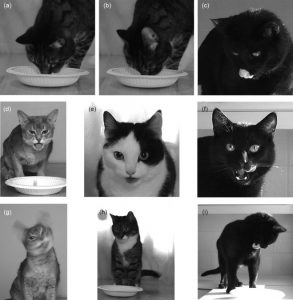
One of my favorite things about the study was the pictures of the cats engaging in the behaviors. You really don’t realize the kinds of faces your cats make while they’re eating until you see video stills of it!
It would be nice to see the study have a little more standardization about what the favorite and least favorite food items were. I assume all of the favorite foods were wet/canned if they were trying to hide a tablet inside. I’d be curious if cats’ behaviors were similar for dry food. It’s also hard to look at eating behaviors if it’s something the cat doesn’t want to eat…how many cats actually put the cucumber or lettuce in their mouths?? But the study did reveal some very interesting patterns in cats’ eating behavior, that could certainly inform future studies and tell us more about the behavior of cats. Moreover, their goal of trying to develop easier ways to administer medication to cats is an honorable one!!
On that note, if you need some tips on pilling your cat I recommend Kris Chandroo’s Stress to Success program, which I have previously blogged about. You can also check out this video from Fundamentally Feline!

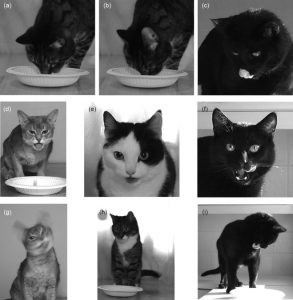
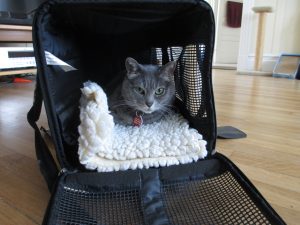
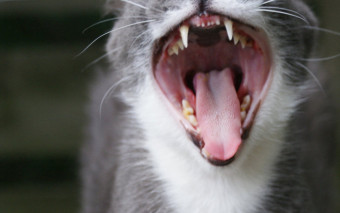
Ive actually noticed my cat can tilt his head to one side while eating and/or drops food on the floor when he has a bad tooth so it’s sometimes a sign of a dental problem.
Mark, absolutely true! But we know it’s also part of the cat’s natural eating repertoire…another good reason to make sure a vet checks your cat at least once a year, including their teeth!
I noticed that if I give our kitten a piece of food she would shake if when she actually bites it. (P.S. this was very helpful)
Kat, my 11 month old boy also shakes his head hard when he eats cooked meat. I gave him a couple strings of cooked stewed lamb. He loved it but shook the strings hard before eating them sometimes throwing off little pieces of meat from main piece! He tries to shake his kibble bits but that just makes a mess!! I have another who will put a piece of paper over her food bowl!!
I have a question about why do my cats sometimes put their ears flat while they’re eating? Could it be their way of keeping them out of the way? Which actually sounds a little bit silly because the ears are no where long enough to ever get in the way of eating.
In the study I described, flattened ears were associated with eating a less favored food…
Four cat household, One male feral, slowly acculturated to a two female rescue household on his terms and another older male cat who self adopted from down the street after the empty nesters brought home 3 new dogs. The neighbors still have frequent visitation rights. Some drama between cats especially males. All four cats greatly prefer wet food after mashing and adding boiling water to soften it and warm it up to a little above room temperature. The various brands of pate style wet cat food are all refused UNLESS I add the hot water and create a thick soup consistency. Note that 3 of 4 cats are mousers and consume mice outside and sometimes bring mice inside to eat. No relationship between process of eating mice and eating wet cat food from cans as all 4 lap the wet food up and do not chew it at all. Some cats leave the mice heads uneaten, others leave nothing but some dried stains on the carpets to be cleaned. As for wet cat food, the brand preferences seem to largely disappear after everything is reduced to a very wet soupy consistency. Same feeding behaviors observed for all 4 cats. Each cat gets an individual wet food feeding to avoid confrontation and stealing of food.
Three separate dry food bowls for ad libitum dry kibble and 3 water cups. All cats prefer to drink water sitting with front paws extended vs. close to the floor kneeling. That means we see bigger water consumption from 12 oz plastic disposable water cups vs a low boy water bowl. All cats only drink the first 6 oz as they do not like to insert their heads inside the water cups too deeply. Water is changed at least once a day throughout house. All food and drink is designed to encourage extra water consumption due to dealing with kidney failure in older cats. I have observed that for a feeding station upstairs and very close to a litter box, the dry food consumption is the same for downstairs feeding areas BUT the water consumption for water placed 3 feet from a litter box is reduced compared to water placed in a separate bedroom. It might be that cats prefer to drink water away from their latrine areas even indoors.